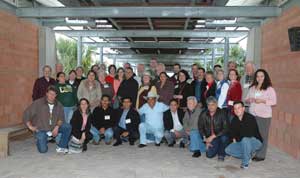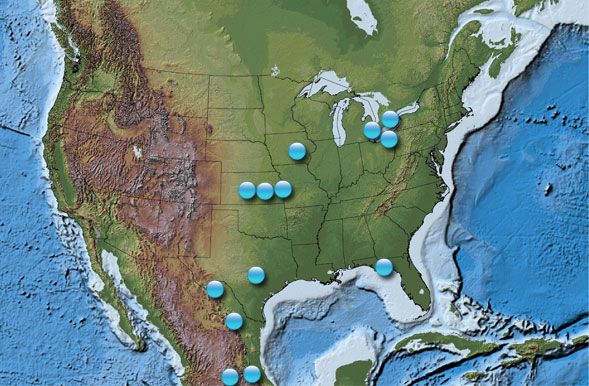Conservation in North America

Participants of the Monarch Flyway Conservation Workshop, Mission Texas, December 2006. Photo by Carol Lively.
The persistence of the monarch butterfly’s spectacular and unique migratory phenomenon is dependent on the conservation of habitats in Canada, the United States, and Mexico. No species better symbolizes the ecological links among the three countries.
Many government agencies, organizations, and individuals across North America are working on projects to conserve monarch habitats and the migration phenomenon.
Protecting Mexico’s Forests
Mariposa Monarca Biosphere Reserve
The high altitude forests that provide winter habitat for hundreds of millions of monarch butterflies are on the borders of the states of Mexico and Michoacan. In 1986, the Mexican government created the Monarch Butterfly Biosphere Reserve (Mariposa Monarca Biosphere Reserve) to protect 62-square miles of forests within four separate monarch sanctuaries. In 2000, the Biosphere Reserve was expanded to include 217 square miles.
The Monarch Butterfly Biosphere Reserve is a part of Mexico’s federal system of protected areas. Federal protected areas in Mexico are administered by the National Commission of Natural Protected Areas (Comision Nacional de Areas Naturales Protegidas) (in Spanish).
Working with Local Communities
Much of the land within the Monarch Butterfly Biosphere Reserve is communally owned “ejido” land. The residents of the ejidos are poor farmers who have relied on these forests for lumbering, firewood and construction material for generations.
Although logging was outlawed in the core zone when the Monarch Butterfly Biosphere Reserve was created in 1986, illegal logging remains a problem today. Deforestation threatens the wintering habitat of the monarch butterfly.
A number of organizations are working to promote sustainable forestry practices, forest conservation and reforestation, and help residents to find alternative ways to supplement their incomes.
- The La Cruz Habitat Protection Project and Michoacan Reforestation Fund work to protect monarch butterfly habitat and improve the well-being of Mexican communities through reforestation.
- Alternare (in Spanish), a nonprofit organization founded in 1998, works to help local residents find sustainable, income-producing alternatives to logging in the Monarch Butterfly Biosphere Reserve.
U.S. Fish and Wildlife Service (USFWS) - Wildlife Without Borders - Mexico Program
Since 1995, the USFWS Wildlife Without Borders - Mexico grants program, in partnership with Mexican authorities and non-governmental organizations, has invested over $700,000 in projects to protect and restore the wintering habitat of the monarch butterfly. For example, the Service partners with Mexican authorities and ALTERNARE, A.C. to support a training program to develop the natural resource management capabilities of local communities. Training has included soil and water conservation, use of organic fertilizer to increase crop production, income generating activities such as bee keeping, and construction of solar powered cooking boxes and adobe houses to reduce the need for firewood. The Service has also funded programs to provide training in reforestation techniques for peasant farmers living in the Reserve.
U.S. Forest Service International Programs
Since 1993, the U.S. Forest Service International Programs has been working with Monarch Butterfly Biosphere Reserve managers and partners in the region to build management capacity, to provide guidance to communities for resource management, and to conserve natural resources in the core zone of the Reserve. Staff from the Willamette National Forest and other units has provided training and consultations to the Reserve on forest inventory, GPS/GIS utilization, and design and maintenance of trails. Through a partnership with the Monarch Model Forest, partners developed proposals to help the Model Forest with recreation management, landscape ecology, small-scale wood product development and marketing, and community incentive programs. Working with local communities adjacent to the Monarch Butterfly sanctuaries, project participants worked to reforest lands using native tree species-with the long-term goal of establishing alternative sites for extracting wood. Apart from reforestation, the Model Forest and its partners have worked on recreation and eco-tourism.
A Continental Approach
North American Monarch Conservation Plan
Representatives of agencies, academia, and non-governmental organizations from Canada, the United States, and Mexico are working together to develop a North American Monarch Conservation Plan to address monarch conservation utilizing a habitat-based flyway approach. This continental planning effort was launched at a December 2006 Monarch Flyway Conservation Workshop sponsored by the U.S. Forest Service, U.S. Agency for International Development, Texas Parks and Wildlife Department, The Wildlife Trust, and the City of McAllen, Texas. A nine-member planning committee has been formed to develop a plan that addresses monitoring, habitat conservation, and public outreach and education.
Trilateral Monarch Butterfly Sister Protected Area Network
The Trilateral Monarch Butterfly Sister Protected Area (SPA) Network is a partnership of wildlife refuges and national parks in the United States and Canada, and natural protected areas in Mexico working together on monarch conservation projects. The SPA network is a project of the Trilateral Committee for Wildlife and Ecosystem Conservation and Management. The project was initiated in May 2006 to collaborate on monarch habitat preservation and restoration; research and monitoring; and environmental education and public outreach.
Select the points on the map below for more information about some of the protected areas.

Trilateral Monarch Butterfly Sister Protected Area Network. Base map source: USGS National Atlas.
Protection Efforts in Canada
The monarch butterfly is listed as a species of special concern and protected under Canada’s federal Species at Risk Act. More information about the status of the monarch and efforts at protection in Canada is available at the Environment Canada Species at Risk website.

